
Normally, fall intake takes a similar structure across the world. Students shuffle into new classrooms, campuses, and in some cases, countries, excited and ready to kickstart their studies.
This fall, however, will be anything but normal. Each country has its own health and safety guidelines for higher education institutions, and in many cases, individual schools have the option as to whether they’re going to reopen their campuses, remain online, or a mixture of both. While this no doubt causes logistical headaches for admissions staff, it can also cause confusion amongst prospective students.
Not only are they unsure of what their fall semester will look like—many are also concerned about their health and safety. These students will be looking to your school’s online channels for updates and reassurance, so it’s important to make sure that your digital marketing strategy does just that.

1. Add “Update Website” to Your Digital Marketing To-Do List
Whenever your school undergoes any sort of change—whether it involves courses, facilities and services, or your campus—updating your website should be first on your list of digital marketing priorities. Your website is essentially a reflection of your school in digital form, so it’s important to make sure the information it presents is accurate and up to date.
This is especially true in the current context. Every school has their own approach to reopening, with some opening completely come September, others having in-person classes for certain courses, and other schools permitting certain groups of students on campus at a given time. What’s more, each school has its own safety rules and regulations for students.
When a prospective student first visits your school’s website, this is the sort of information they’re likely going to look for first. Whether your school offers in-person or online classes, and whether you have the proper protocols in place to ensure your students’ safety, are the top priorities for today’s prospects.
As a result, this is the sort of information you should make immediately accessible on your school’s site.
One of the best ways to do so without disrupting the overall design of your site is to add a CTA—whether in banner form or as a menu item—directing visitors to your latest reopening updates.
Example: The COVID-19 updates banner on Harvard University’s website. Including a link to COVID-19 updates on your site’s primary navigation will ensure students can access it no matter what page they’re on.

The next step is to pay attention to the page that these links direct users to. Since your school’s reopening plans have likely changed over time, it’s important to make sure that this page is intuitively organized to foreground the most recent updates.
Some schools have created a single page that lists the most recent COVID-19 updates in chronological order, whereas others have a more robust directory with its own submenu. How you structure this page will depend on how much information and resources that your school has regarding its reopening plan.
Example: The Coronavirus Information section of Algonquin College’s site, which students can access through the Updates button. Messages from the college are organized chronologically, with short summaries beside each link.
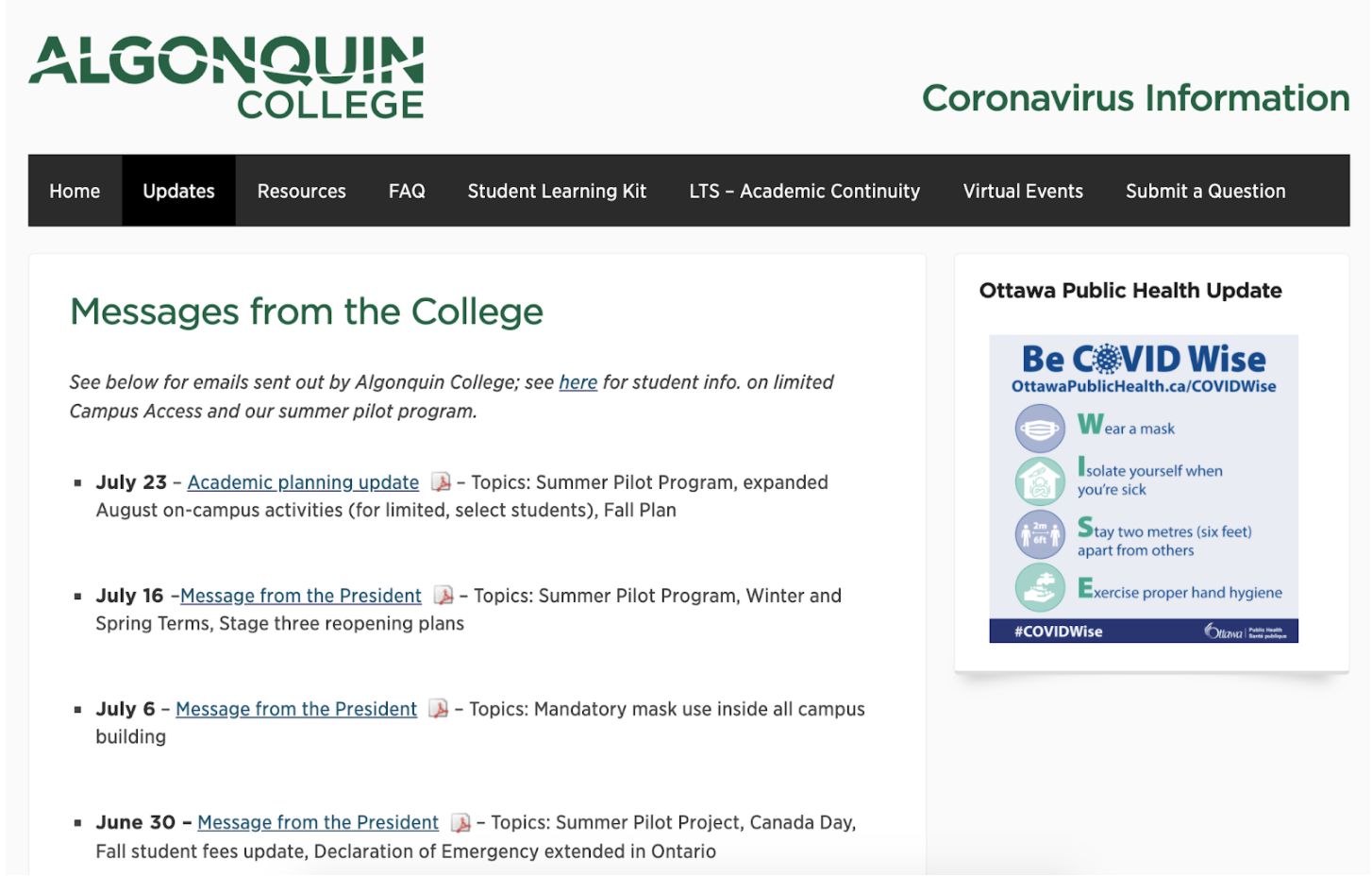
Regardless of which format works best for your school, pay close attention to the text on the page. It’s imperative that your school strikes the right tone when relaying reopening information. Prospects and current students will be looking for reassurance that their safety will be prioritized if, or when, they return to campus.
Example: Automotive Training Centre’s ‘Safety Plan’ page, which prospects access when clicking the Important information on COVID-19 CTA. Although the page does include reopening info, calling it a ‘Safety Plan’ and focusing on what the school is doing to prevent the spread of COVID-19 is likely to resonate with both current and prospective students alike.

If there is specific information your school needs to relay to different types of website visitors, you may want to consider creating separate pages for your COVID-19 updates in order to tailor the information you present. This can also prevent confusion if your school has different rules for students in different programs, or for future and current students.
Example: McGill University’s Covid-19 ‘Help and Information’ page. This page highlights the latest and most important information, and directs visitors to pages specific to the information they’re looking for.

These updates are essential in making sure that your website is up to date with your school’s current plans. But if you want to take your higher ed digital marketing strategy for your reopening a step further, consider updating other areas of your school’s site to reflect the changing situation.
We recently did a blog on updating your school’s website for online learning, where we outlined different ways you can showcase your school as a reputable online course provider to attract students interested in remote learning. The same mentality applies for your reopening: your website should show why students should opt for studying on your school’s campus.
This could involve updating key elements on your homepage to highlight the reopening of your school.
Example: The homepage of SMU, a private university in Texas. The headline and cover image spotlights the school’s reopening, and the CTAs direct visitors to updates, resources, and information related to its plans for Fall 2020.

This is also a good time to look through your school’s website and update any online learning-related information to prevent confusion amongst prospective students.
2. Develop a Content Marketing Strategy for Your School’s Reopening
After making the needed updates to your school’s site, consider adding additional resources prospects can use to learn more about your school’s reopening plans and feel confident about them.
While updating your website will give students the facts about your school’s reopening plans, creating content allows you to go into greater detail and depth about the subject, which will help your students better understand your approach. It will also help you reach more prospects via different channels and make them aware that you are open for on-campus learning once again.
Blogs, in particular, are a great way to provide insight into particular aspects of your school’s reopening plan. You can address any questions your current students may have about their course schedule, for instance, or show future students how they can safely interact with one another during their studies. Blogs are also a great way to introduce your school’s reopening plan in a more personable and entertaining format, which can help students feel much more comfortable about it.
Example: A blog by Randolph-Macon Academy, which showcases the various safety measures the school will be undertaking when it reopens.
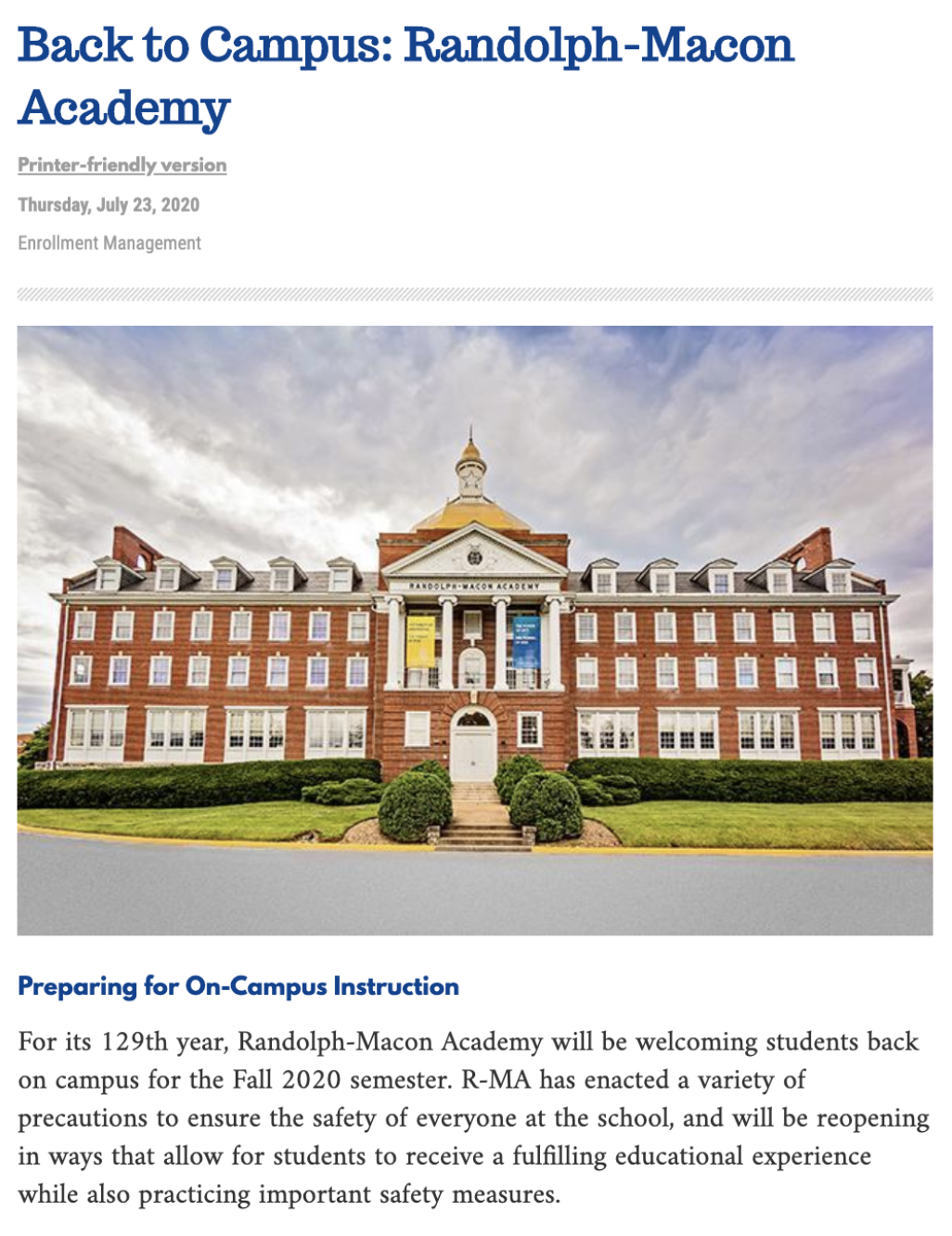
Blog posts are also a great resource to have if a prospective student inquires about your school’s reopening plans. You can also include links to them in other elements of your digital marketing strategy for education, such as email workflows and social media posts.
In addition, your school may want to add video content to your marketing mix in order to give prospects a better sense of what life will look like when your campus reopens.
Example: A video from Duke University’s president on the school’s reopening plans. Listening to someone talk about a school’s reopening plans, instead of simply reading about them, can have a major impact on your prospects’ decision-making process during the pandemic.

You could also use video to visually showcase any changes you have made to the campus to prepare for reopening, such as reorganized layouts of classrooms and common spaces to allow for social distancing.
Example: Stony Brook University created this video demonstrating how its social distancing on campus will work in the fall.

If you want to take your school’s reopening marketing strategy to the next level, you could create content specifically for your COVID-19 information pages. After all, the more resources you can pack into this section, the more likely prospects are to have their reopening questions answered when they visit your website.
Example: The reopening section of the University of Calgary’s website. Prospects can access pages dedicated to each aspect of the reopening plan, as well as browse a comprehensive FAQ that is organized by each segment of the University’s audience.
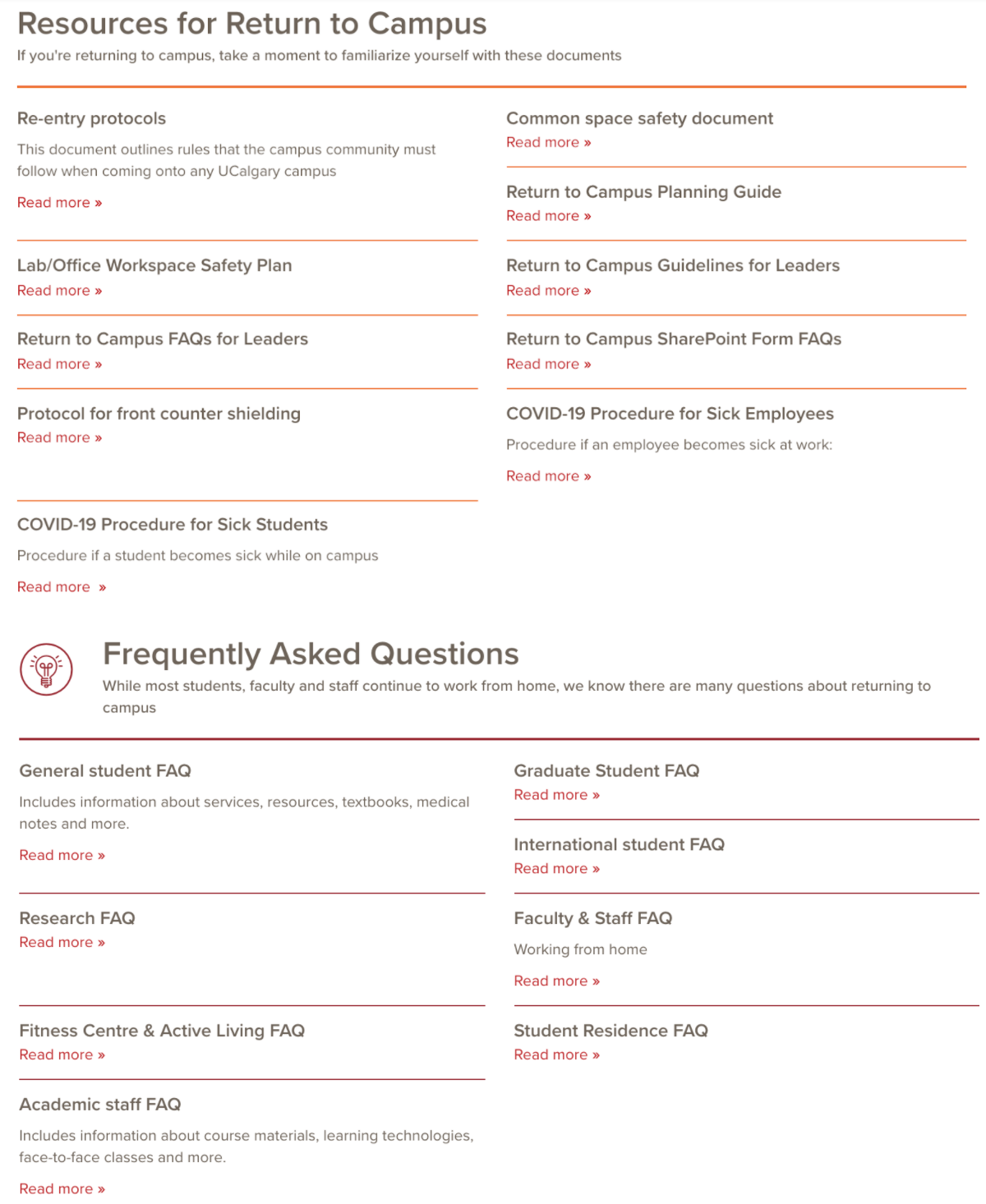
If you want to show that your school has put ample thought into its reopening plan, creating content is a great way to do it. Reopening-specific content demonstrates your school’s understanding of its prospects’ concerns, hopes, and questions during this uncertain time in the education sector. This confidence is key to them feeling comfortable and excited about resuming studies in a physical classroom environment.
3. Broadcast Your Reopening Plans on Social Media
Social media has become the go-to place for the latest news. 55% of adults get their news from social media, and everyone from politicians to businesses regularly use it to communicate important messages.
With reopening information constantly in flux, it’s important to keep your school’s social channels up to date. This is especially important if you have a young audience, as there’s a greater likelihood that your students are spending a great deal of time on social media, so it will make it easier for them to keep up with your school’s plans.
Example: A reopening update on the University of British Columbia’s Facebook page. Every social media update includes a video with subtitles and a link to the corresponding web page. Adding multimedia components to your reopening posts will maximize engagement.
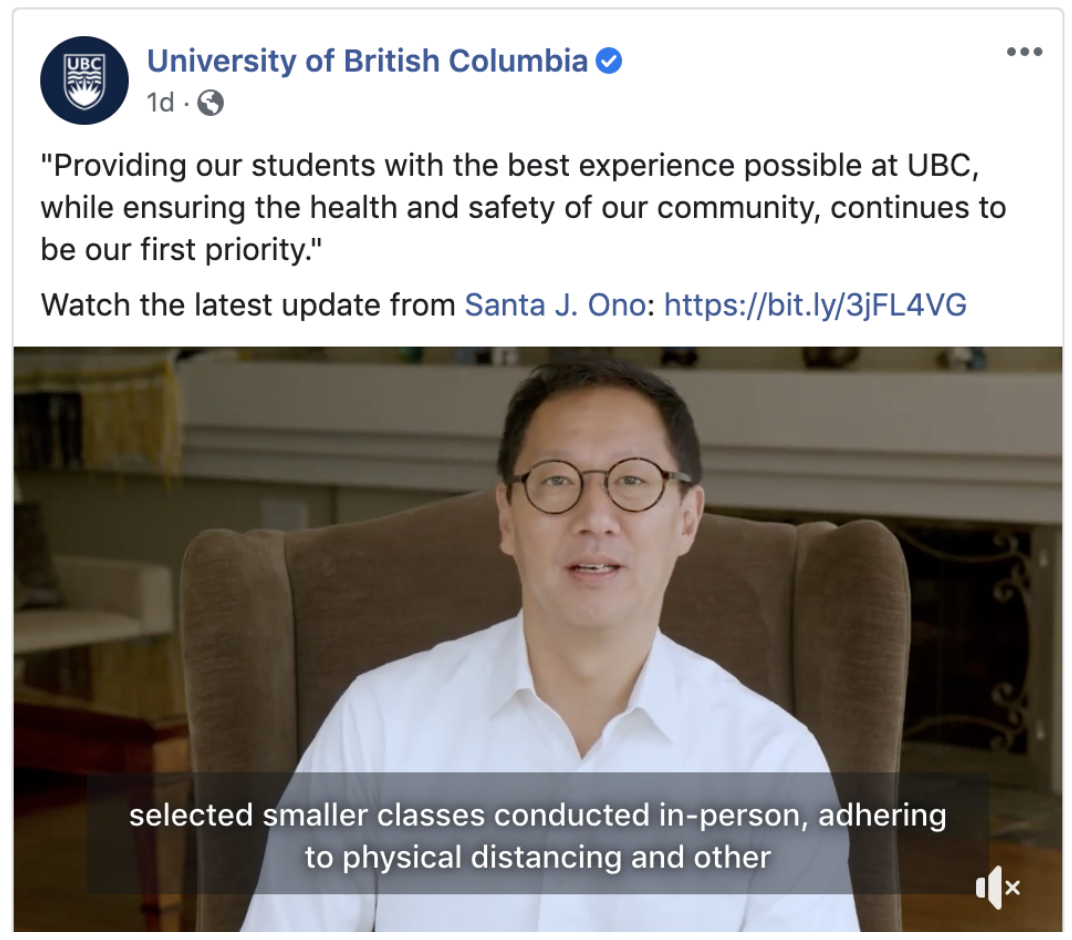
Keep in mind, however, that your school’s social media strategy for its reopening plan doesn’t have to be solely about communicating the necessary protocols and procedures. You can get creative with how you present your reopening plans to engage your community.
During the height of COVID-19, your school’s posts likely focused on highlighting your school’s online courses, instead of, for instance, its campus location or travel opportunities. But when your school starts to open its doors, you can showcase these selling points once again.
You can also use social media to get your audience pumped about your school’s reopening—but make sure to always maintain an appropriate tone, as your school wants to show that it is taking its reopening seriously.
Example: Posts on the Centre of English Studies’ Instagram counting down the days until the campus is open for business.
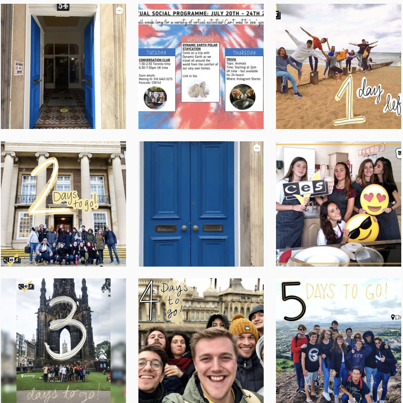
4. Create a Higher Ed Digital Marketing Strategy for Email
Email marketing has long been a tried and true digital marketing strategy for education—but during the pandemic, it has taken on a new level of importance.
Unlike your school’s website and social channels, sending emails is a direct way to communicate with future and current students en masse, instead of hoping that people will follow your updates regularly.
Since email marketing is a highly versatile digital marketing tool, there are many different ways you can relay your reopening plans in targeted and personalized ways. But before you start creating new email campaigns, it’s important to make sure that any active workflows or autoresponders your school has are up to date.
When a student submits an inquiry form or clicks a ‘request info’ CTA, what kind of messages are they receiving? It’s important that the information included in these messages are accurate and reflect your current situation, but it can be time-consuming to create new autoresponders with the latest information every time your school’s reopening plans change slightly.
As a result, your school may want to create general autoresponders—updating them only after major developments—that link to your school’s COVID-19 updates page. That way, they can check out the latest news themselves without you having to constantly rewrite your emails.
Example: An autoresponder from The New School, which mentions the school’s plan to remain online in the fall, and includes a CTA that directs recipients to its 2020-2021 Academic Plans page.

When a major change in your school’s upcoming plans does occur, however, your school can not only update your autoresponders and workflows, but create new standalone emails to send out to your contact database. This way, you can keep your current students up to date, and offer prospective students information that may sway their decision about whether to study at your school.
Example: An email from West Virginia University College of Law that announces the school’s intention to reopen in Fall 2020. The quote at the top of the email summarizes the school’s reopening update, so prospects are immediately made aware of the school’s plans, and the body text goes into greater detail.

Your school can also build new workflows dedicated to your reopening in order to address each element of your plan in greater detail, just as we suggested you can do in your content marketing efforts.
Example: A sample workflow for a school’s reopening plan. You can spice up these emails by including videos, blog posts, and any other reopening-related resources your school has created.
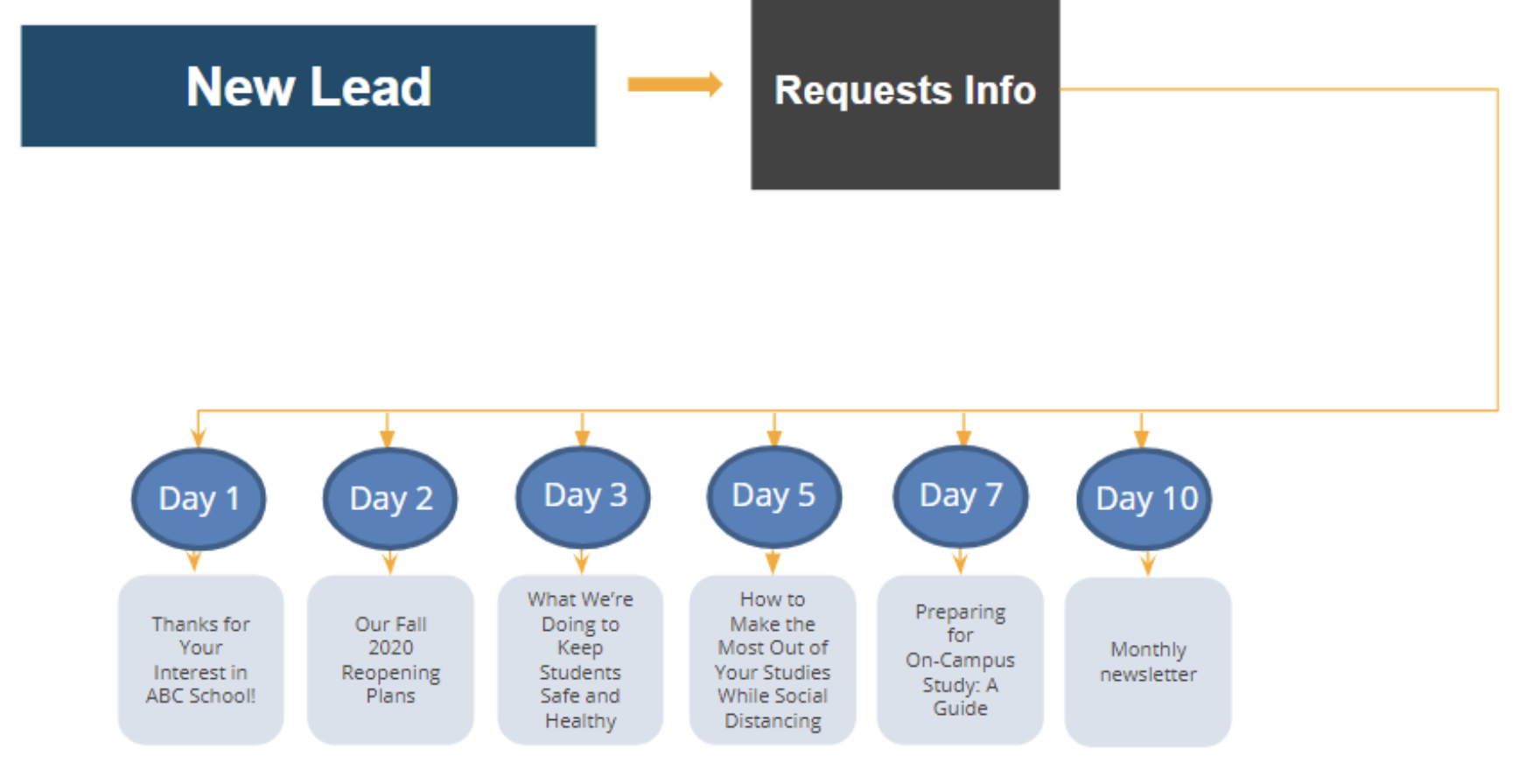
Keep in mind for any emails you create, as well as all other aspects of your reopening strategy, that some students are highly skeptical about returning to campus. The thought of studying in a crowded library or joining clubs can cause apprehension instead of excitement for some. Whenever you’re discussing the different opportunities and features your campus offers, make sure to focus on what your school is doing to make these activities as safe as possible.






